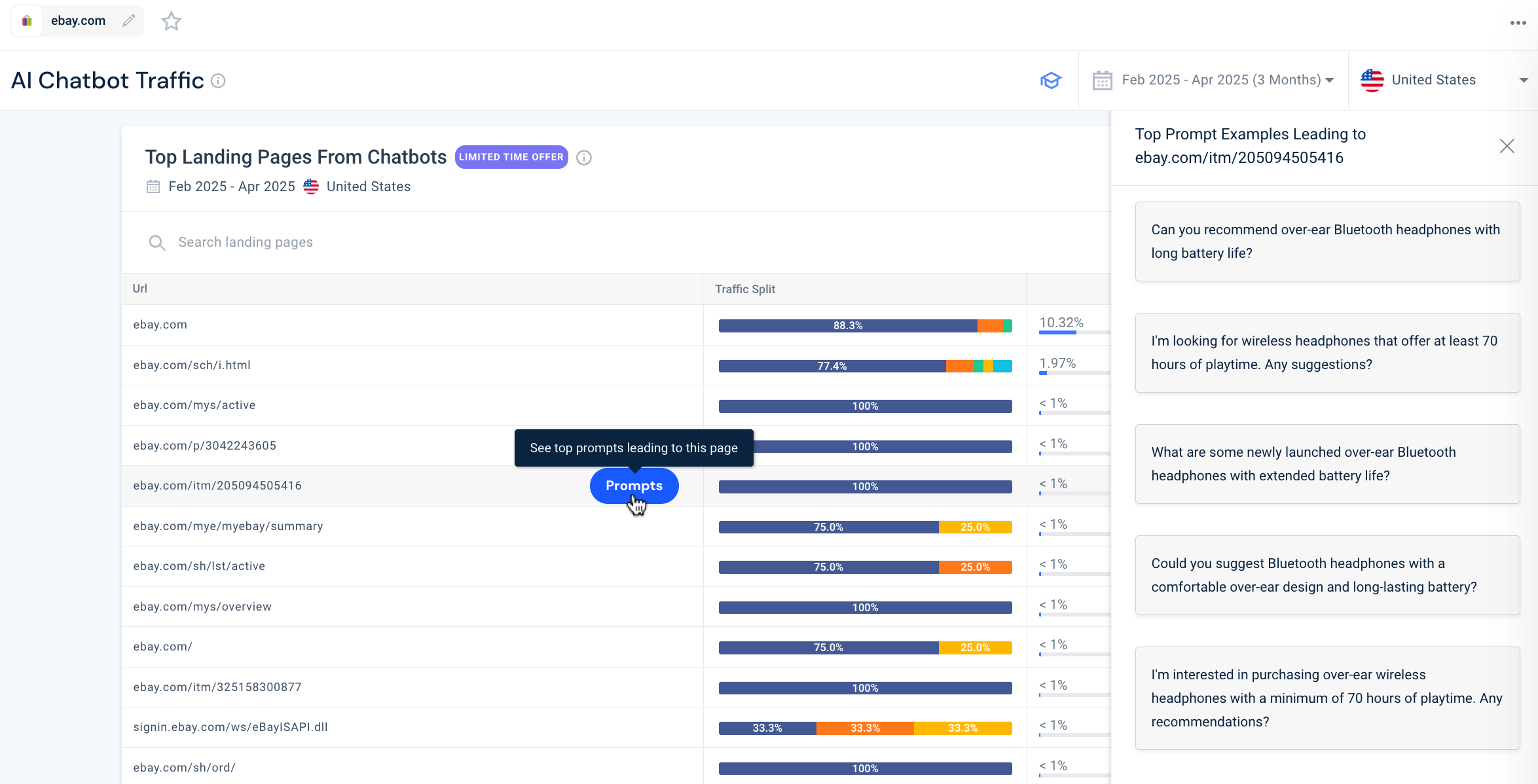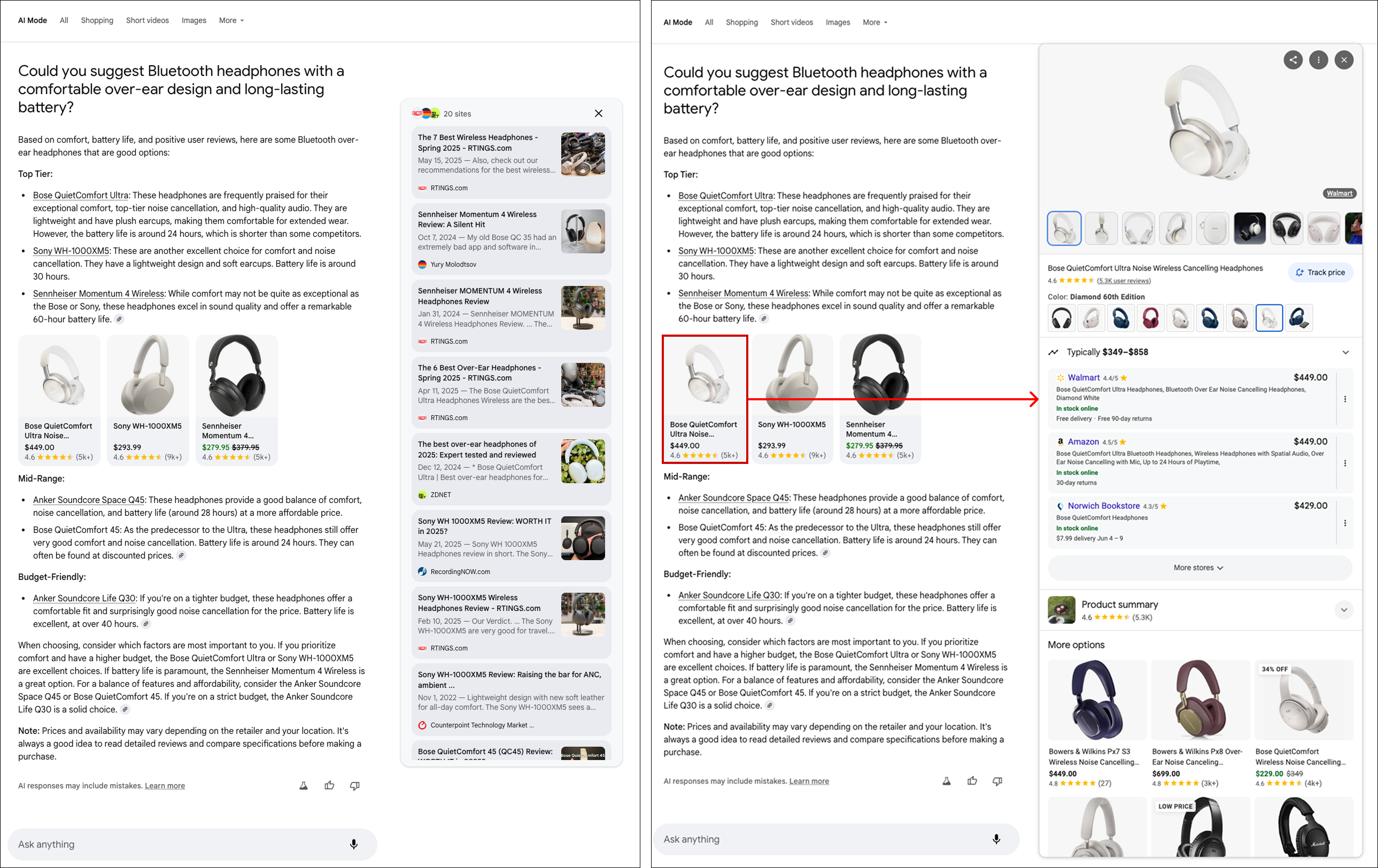Earlier this week at Google I/O, and after just 3 months of its release in test mode, Google officially launched AI Mode in the US, providing a conversational, multimodal, and task-oriented assistant experience, expanding the role of AI Overviews with more advanced reasoning.
Google also explained how starting this week AIO’s and AI Mode will start using a custom version of Gemini 2.5, -their current most intelligent model-, serving as a testing ground for new features with user feedback to be taken into account to shape its evolution.
One of the keys for AI Mode, is that it uses a query fan-out technique, that Google explains as follows:
“AI Mode uses our query fan-out technique, breaking down your question into subtopics and issuing a multitude of queries simultaneously on your behalf. This enables Search to dive deeper into the web than a traditional search on Google, helping you discover even more of what the web has to offer and find incredible, hyper-relevant content that matches your question.”
So, How Does AI Mode’s Query Fan-Out Technique Work?
Query fan-out is an information retrieval technique that expands a single user query into multiple sub-queries to capture different possible user intents, retrieving more diverse, broader results from different sources -including the live web, knowledge graph, and specialized data like Google shopping-, allowing to deconstruct complexity, especially beneficial for comparative analyses, multi-criteria decision-making, and questions requiring synthesis from different sources, to provide a comprehensive response.
When a user submits a query in AI Mode, Google’s systems analyze the query using advanced natural language processing to establish among others, user intent, complexity level, and the type of response needed, and if fan-out is necessary.
Simple factual queries like “capital of Spain” might not trigger extensive fan-out, while complex queries like “how to optimize website performance” would activate the fan-out process extensively.
By “fanning out” the original query, the system can explore various facets and subtopics simultaneously based on semantic understanding, user behavior patterns, and logical information architecture around the topic, leading to a more complete and contextually rich understanding of the user’s need.
Unlike traditional search where one query returns one set of results, AI Mode simultaneously retrieves information for all fan-out queries. This happens in parallel, expanding the information pool available for answer synthesis, evaluating the content using Google’s ranking and quality signals, combining information from multiple sources and fan-out queries to create a coherent, comprehensive response that addresses the original query while incorporating relevant supporting information.
A Query Fan-Out Example
Let’s look at how query fan-out would apply in a real world scenario by using an actual prompt via Similarweb AI Chatbot Traffic report, which shows not only the AI traffic of any site, but also the AI traffic per page, and the top prompts leading each.
For an ecommerce example, let’s select a prompt generating traffic to an ebay product page, an Over Ear Bluetooth Headphone:
“Could you suggest Bluetooth headphones with a comfortable over-ear design and long-lasting battery?”

Let’s remember the fan-out technique covers many facets of the original query, anticipating users follow-up questions or underlying needs they might have, so in this particular case Google’s AI should recognize the original query mentions design (over-ear, comfortable), technology (bluetooth), and performance (long-lasting battery). These are core facets.
The system should check for related intents, like “charging speed” or “portability” -which a user might implicitly care about. It may draw on synonyms (like “long battery life” and “long-lasting battery”). It doesn’t assume the user is asking just for one product list. Sub-queries might target:
- Product listings (Shopping graph)
- Expert reviews and comparisons (Review pages, editorial content)
- User reviews and experiences (Forums, product reviews)
- Technical specs and features (Official product pages, specification sheets)
All this would end up resulting in sub-queries like:
Facet | Sub-Query |
General product discovery | “Best Bluetooth headphones with over-ear design” |
Entity-based query | “List of top-rated over-ear Bluetooth headphones with long battery” |
Comfort-focused | “Most comfortable over-ear Bluetooth headphones” |
Battery performance | “Bluetooth headphones with longest battery life” |
Combined comfort and battery | “Over-ear Bluetooth headphones with comfortable fit and long battery life” |
Price range (implicit facet) | “Affordable over-ear Bluetooth headphones with good battery life” |
User experience | “User reviews of Bluetooth over-ear headphones with long battery life” |
Comparison by brand | “Sony vs Bose vs Sennheiser over-ear Bluetooth headphones with long battery life” |
Design quality | “Best build quality over-ear Bluetooth headphones” |
Battery technology | “Which Bluetooth headphones have best battery technology (e.g., fast charging)?” |
Portability (implicit) | “Lightweight over-ear Bluetooth headphones with good battery life” |
Noise isolation (common factor) | “Bluetooth over-ear headphones with noise-cancelling and long battery” |
Battery charging time | “Which Bluetooth over-ear headphones charge fastest?” |
Here’s the answer when performing this search in Google’s AI Mode (the lab version, since I still don’t have access yet to the live one), in which it can be seen how it features:
- A list of recommended products, with reasons why they’re chosen.
- Product packs including specifications with reviews, that when clicked display product knowledge panels showcasing options from vendors to directly buy it, along with related products.
- Summaries of comfort features and battery performance.
- A sidebar with links to the 20 pages from where the information was sourced, also linked from icons showcased at the end of paragraphs.
What does this mean for SEO?
For SEO specialists, the query fan-out technique has some key implications:
- The need of deeper intent understanding: The AI deconstructs the query into its core intents and related sub-questions, so SEOs need to move beyond simply optimizing for single keywords and instead focus on understanding the entire user journey and the many questions someone might ask around a topic.
- Comprehensive Topical Authority: Instead of just ranking for individual pages, content strategies must aim for topical authority. This means covering a subject exhaustively, addressing all relevant sub-queries and facets, and linking them semantically.
- Anticipating Follow-Up Questions: The AI’s ability to engage in conversational search means content should naturally lead users to their next questions and provide those answers, even if they’re not explicitly asked in the initial query.
Because of the above you’ll need to embrace an “answer a facet” mentality in your content.
For any broad topic you target, you’ll need to brainstorm the sub-questions or angles a user might explore, and provide in-depth, focused answers for each subtopic, to increase the chances that your content will be chosen to answer one of the AI’s fan-out queries.
Organizing your site content into clear topic clusters becomes even more important, since each cluster centers on a broad theme and includes multiple pages or sections addressing specific subtopics -or facets- of that theme. This doesn’t only help users to browse your content but allows you to show comprehensive coverage reinforcing your topical authority.
A few SEO tools can help you to put this into practice:
- AlsoAsked: Allowing to understand your users with live “People Also Asked” data and intent clustering by Google.
- Keyword Insights: Including a keyword discovery feature that sources live data from Google Autocomplete, Reddit, and People Also Ask, besides search intent classification and content clustering features.
- Waikay: Letting you to identify your topic gaps of your content vs competitors.
- InLinks: Entity based analysis of your site, structured data and internal linking implementation.
The above should complement content related criteria that should be prioritized further when optimizing for AI Answers:
- Increased EEAT importance: Since the AI is synthesizing information, it relies heavily on trustworthy sources. Content from authors and websites demonstrating strong EEAT signals, like credentials, original research, positive user reviews, strong brand reputation and authority, mentions from other authoritative sites, will be prioritized.
- Unique insights become an advantage: Unique, proprietary data, original research, and first-hand experiences that AI cannot easily replicate or find elsewhere become really valuable.
- Scannable and digestible formats: Content needs to be structured in a way that AI can easily parse and summarize. This means clear headings, subheadings, bullet points, numbered lists, and concise answers to common questions.
- Bigger role of Brand mentions: Unlinked brand mentions and positive sentiment across the web are signals to assess trustworthiness and recommend your brand.
The query fan-out technique used by AI Mode is changing search from a query-focused process to a context focused one and the way we optimize (as well as measure) our content must evolve accordingly.
Want to learn more to optimize your content for AI Search?
- SEO VS GEO: Optimizing for Traditional vs AI Search by Yours Truly
- A guide to Semantics or how to be visible both in Search and LLMs by Gianluca Fiorelli
- How publishers can adapt to AI Mode and LLMs: a strategic framework beyond classic SEO by Gianluca Fiorelli
- Top ways to ensure your content performs well in Google’s AI experiences on Search by John Mueller from Google
- Mastering AI-Powered Search: Next Level Strategies for Marketers by Fabrice Canel, Krishna Madhavan from Microsoft
- Google AIO’s, AI Mode and LLMs Optimization at LearningSEO.io
Google’s AI Mode Sources:
